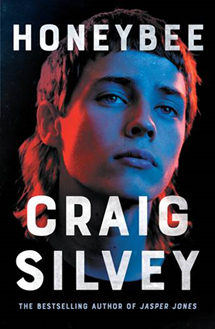Reviewed by Robert Goodman.
By Craig Silvey, Allen and Unwin, $32.99.
 Australian author Craig Silvey is best known for his novel Jasper Jones, which followed the exploits of a thirteen year old boy in a small Western Australian town in the 1960s. Silvey is far from the first novelist to write from a young person’s point of view to expose truths about the adult world. His latest book, Honeybee, is contemporary but he takes a similar approach. While the narrator is a fourteen-year-old, and often acts like one, and this is a coming-of-age story of sorts, this is not a book that sits neatly as young adult fiction as once again Silvey is trying to explore deeper, more complex societal issues. This review contains some spoilers about those issues but ones that have been fairly well vented in the media coverage of this book already.
Australian author Craig Silvey is best known for his novel Jasper Jones, which followed the exploits of a thirteen year old boy in a small Western Australian town in the 1960s. Silvey is far from the first novelist to write from a young person’s point of view to expose truths about the adult world. His latest book, Honeybee, is contemporary but he takes a similar approach. While the narrator is a fourteen-year-old, and often acts like one, and this is a coming-of-age story of sorts, this is not a book that sits neatly as young adult fiction as once again Silvey is trying to explore deeper, more complex societal issues. This review contains some spoilers about those issues but ones that have been fairly well vented in the media coverage of this book already.
When the book opens, the narrator Sam Watson is contemplating suicide for reasons that later become clear. He is talked out of it by an old man called Vic, although Vic had been thinking about something similar. Out of this the two form a friendship, one that is a little reminiscent of the one at the centre of Tim Winton’s recent novel The Shepherd’s Hut. It is a platonic relationship and a safe space in which Sam can start to explore his identity and make new friends who might accept him for who he is. But it is a relationship that is not well accepted and before long Sam is back with his drug-addicted mother and her criminal boyfriend.
The story centres on Sam and his struggle to express his identity. Sam feels wrong in his body, but als,o as a fourteen year old, he misreads plenty of situations and makes terrible choices. Silvey effectively captures the confusion and self-doubt at the heart of Sam’s character but also the small flame of hope that Vic and later his other new friends help him nurture.
As was the case with recent controversy over Jeanine Cummin’s book American Dirt, there has been some debate around Silvey’s capacity, and even his right, to write a novel from the point of view of a trans character. Silvey’s defence, and that of all authors ultimately, is that writing is a form of ventriloquism, and that authors are always writing about or from the perspective of people who are not themselves. He accepts that the book does not emerge from his own experience but that writers are required to “listen and learn” and that he has tried in his research through the writing of the novel to present at least a version of something true and not present caricatures rather than characters. Readers will have to decide for themselves, keeping in mind that besides Sam, Silvey delivers a wide cast of vivid and complex characters.
There is an element of wish fulfilment here, particularly in the last quarter of the book. Sam ends up in a bit of clover and with a veritable cheer squad of people focussed on looking out for him doing their best for him. One interesting aspect of this is the way that Sam’s self-doubt hinders his ability to deal with those elements of good fortune.
Honeybee is very much a character study. There is little in the way of narrative tension other than wondering how (and sometimes if) Sam is going to grow up and whether he will succeed or be brought down by the environment in which he finds himself. But there is plenty of emotion and emotional pay-off and ultimately a compassionate view of the complexities of sexual identity.
This and 500 more reviews can be found at www.pilebythebed.com.











